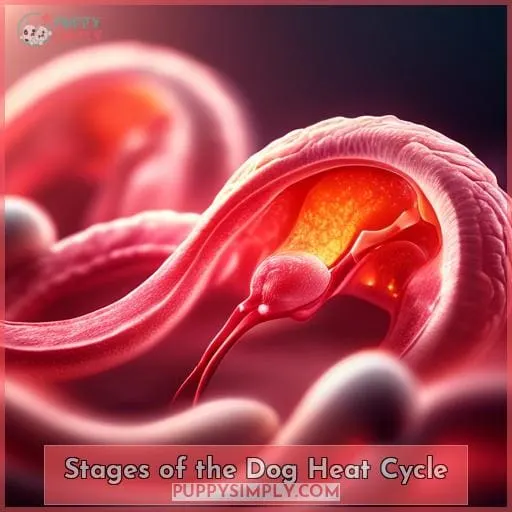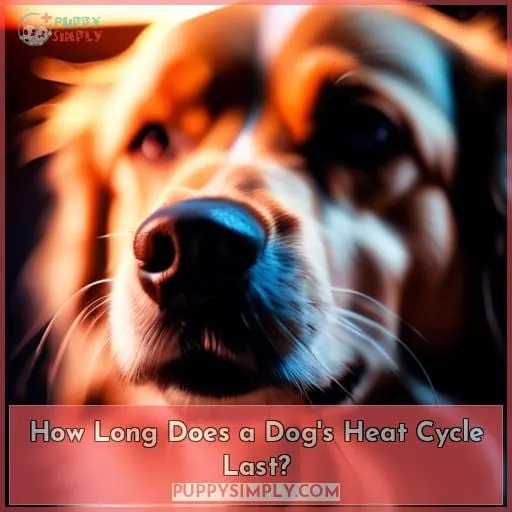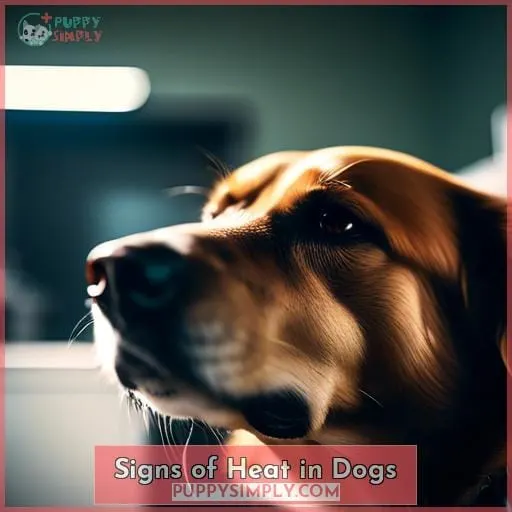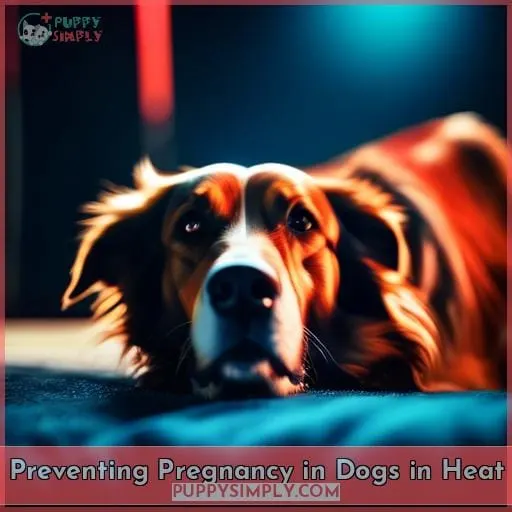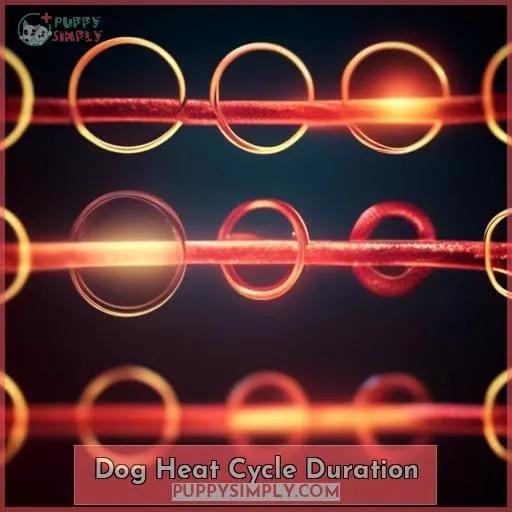This site is supported by our readers. We may earn a commission, at no cost to you, if you purchase through links.
 The duration of a dog’s heat cycle, also known as estrus, can vary among breeds and individuals.
The duration of a dog’s heat cycle, also known as estrus, can vary among breeds and individuals.
Understanding the stages and signs of heat can help you provide proper care for your pet during this time.
This article will explore:
- The average length of a dog’s heat cycle
- The stages involved
- How to recognize the signs of heat in your dog
We’ll also discuss:
- How often dogs go into heat
- The average age at which they first experience it
By understanding these aspects, you can better support your dog’s reproductive health and well-being.
Table Of Contents
- Key Takeaways
- Stages of the Dog Heat Cycle
- How Long Does a Dog’s Heat Cycle Last?
- Signs of Heat in Dogs
- How Often Do Dogs Go Into Heat?
- What is the Average Age Dogs First Go Into Heat?
- Caring for a Dog in Heat
- Preventing Pregnancy in Dogs in Heat
- When to Consult a Veterinarian About a Dog in Heat
- Spaying or Neutering to Prevent Heat
- Dog Heat Cycle Duration
- Frequently Asked Questions (FAQs)
- How can I tell if my dog is in heat if there is no visible discharge?
- What are the risks associated with a dog’s heat cycle?
- How can I prevent my dog from attracting male dogs during her heat cycle?
- What are the long-term health implications of a dog’s heat cycle?
- How can I prepare my home and routine for my dog’s heat cycle?
- Conclusion
Key Takeaways
- A dog’s heat cycle typically lasts around three weeks, but can range from two to four weeks.
- The stages of the dog heat cycle include proestrus (vulva swells, bloody discharge, increased urination), estrus (most fertile stage, receptive to mating, discharge changes color), diestrus (discharge decreases, vulva returns to normal size, no receptivity to mating), and anestrus (resting phase, no signs of heat, longest stage).
- Signs of heat in dogs include a swollen and reddish vulva, blood-tinged discharge, increased urination, restlessness, desire to escape, increased affection or playfulness, vocalization, and change in appetite.
- Smaller breeds may have their first heat cycle as early as 4 months of age, while larger breeds may not have their first heat cycle until 18 to 24 months of age.
Stages of the Dog Heat Cycle
]
How Long Does a Dog’s Heat Cycle Last?
Now, let’s delve into the question you’re likely pondering: How long does my dog’s heat cycle last?
The answer, my friend, isn’t a one-size-fits-all response. Every dog’s body is unique, just like ours, and their heat cycles can vary in duration.
Typically, a heat cycle lasts around three weeks, but it can range anywhere from two to four weeks.
To make things even more interesting, your dog’s heat cycle can also vary in length from cycle to cycle.
So, it’s important to pay close attention to your dog’s behavior and physical signs to know when she’s in heat and how long it’s likely to last.
Signs of Heat in Dogs
With a swollen and reddish vulva, you can tell your dog is in heat.
You may also notice a blood-tinged discharge, similar to a human period. This discharge may vary in color from pink to red to brown.
Other signs include increased urination, restlessness, and a desire to escape.
Your dog may also become more affectionate or playful than usual.
Understanding these signs can help you determine when your dog is in heat and take the necessary precautions to prevent unwanted pregnancy.
How Often Do Dogs Go Into Heat?
You’ll find your dog’s frequency of going into heat varies depending on her size and breed.
Smaller breeds:
- Typically experience their first heat cycle between 4 and 6 months of age.
-
Go into heat every 6 to 8 months thereafter.
Larger breeds:
- May not experience their first heat cycle until they’re 18 to 24 months old.
-
Go into heat every 12 to 18 months.
Irregular cycles:
- Some dogs may experience irregular heat cycles, especially during the first year or two after reaching sexual maturity.
What is the Average Age Dogs First Go Into Heat?
Your dog’s first heat cycle typically occurs between 4 and 18 months of age.
Smaller breeds tend to experience their first heat earlier than larger breeds.
For instance, small breeds may start as early as 4 months, while giant breeds may not start until they’re 18 to 24 months old.
This variation is due to differences in growth and maturity rates among breeds.
Additionally, some dogs may experience early signs of heat, such as behavioral changes or swelling of the vulva, before their first full heat cycle.
Heat cycle variations can also occur within the same breed, so it’s essential to be aware of the signs and symptoms of heat to ensure proper care for your dog.
Caring for a Dog in Heat
To care for your dog during heat:
- Keep her indoors and use doggie diapers or absorbent pads to manage discharge.
- Select a diaper that’s leakproof, absorbent, comfortable, and secure.
- Change diapers frequently to keep your dog clean and prevent skin irritation.
While she’s indoors:
- Provide indoor entertainment to keep her occupied and reduce anxiety.
- Engage her with interactive toys, puzzle feeders, or hide-and-seek games.
- Create a limited space with easy-to-clean areas and towels to avoid accidents.
Regular exercise is essential:
- Take her on extra walks to reduce stress and provide mental stimulation.
Maintain regular hydration:
- Provide fresh water throughout the day.
If you notice unusual behavior:
- Consult a veterinarian promptly.
Preventing Pregnancy in Dogs in Heat
Preventing pregnancy in dogs in heat involves taking precautions like keeping her indoors to avoid mating opportunities.
To further minimize the risk, consider these measures:
- Utilize Diaper Options: Employ dog diapers or absorbent pads to manage vaginal discharge and prevent unwanted staining.
- Engage in Behavioral Distractions: Keep your dog entertained and distracted with activities like extra walks and playtime to alleviate anxiety and reduce the likelihood of her seeking out male dogs.
- Monitor Heat Cycle Timing: Familiarize yourself with the signs and symptoms of your dog’s heat cycle to anticipate its onset and take appropriate precautions.
When to Consult a Veterinarian About a Dog in Heat
When your dog’s heat cycle seems abnormal, consult a veterinarian for guidance.
Early intervention can prevent health concerns and breeding risks.
Hormonal imbalances, prolonged heat cycles, irregular bleeding, or unusual discharge warrant veterinary attention.
Behavioral changes like excessive anxiety, aggression, or depression may indicate underlying health issues.
Consulting a veterinarian ensures your dog’s reproductive health is prioritized, preventing future complications and safeguarding its well-being.
Spaying or Neutering to Prevent Heat
Spaying or neutering your dog is a responsible choice that can prevent heat cycles altogether. This surgical procedure involves removing the reproductive organs, which eliminates the hormonal fluctuations that trigger heat.
Spaying female dogs before their first heat cycle can significantly reduce the risk of mammary tumors and uterine infections. Neutering male dogs can curb aggressive behaviors, roaming, and urine marking.
Surgical Options:
- Spaying involves removing the uterus and ovaries.
-
Neutering entails removing the testicles.
Hormonal Effects:
- Spaying eliminates estrogen and progesterone production, preventing heat cycles and associated hormonal fluctuations.
-
Neutering decreases testosterone levels, reducing sex drive and aggressive behaviors.
Behavioral Changes:
- Spaying can reduce territorial behaviors, false pregnancies, and roaming.
-
Neutering can curb urine marking, mounting, and aggression towards other dogs.
Long-term Benefits:
- Spaying and neutering can extend your dog’s life expectancy.
- Reduce the risk of certain cancers.
- Eliminate the possibility of unwanted pregnancies.
Dog Heat Cycle Duration
Depending on the breed and overall health of your dog, the heat cycle typically lasts about six months.
However, there’s variability in the duration of the heat cycle among breeds and individual dogs.
Small breeds tend to have shorter heat cycles compared to larger breeds.
For instance, a Chihuahua may have a heat cycle that lasts 10 to 14 days, while a Golden Retriever’s heat cycle may last 21 days.
Additionally, the heat cycle can be affected by:
- Behavioral changes
- Health considerations
- Management of discharge
To ensure your dog’s well-being, it’s crucial to understand the heat cycle’s duration and how it may vary.
| Heat Cycle Duration | Breed Differences | Health Considerations |
|---|---|---|
| 10 to 14 days | Small breeds | Obesity |
| 21 days | Large breeds | Diabetes |
| Variable | Behavioral changes | Infections |
| Health considerations | Cancer |
Frequently Asked Questions (FAQs)
How can I tell if my dog is in heat if there is no visible discharge?
To determine if your dog is in heat despite the absence of visible discharge:
- Observe her behavior and physical signs.
- Look for increased urination, restlessness, and attempts to attract male dogs.
- Additionally, her vulva may be swollen and slightly reddish.
What are the risks associated with a dog’s heat cycle?
The risks of a dog’s heat cycle are as vast as the universe:
- Unwanted pregnancies
- Uterine infections
Protect your beloved companion with timely interventions.
How can I prevent my dog from attracting male dogs during her heat cycle?
During your dog’s heat cycle:
Prevent unwanted canine suitors by keeping her indoors, away from male dogs.
Employ dog diapers or absorbent pads to manage discharge and minimize accidents.
What are the long-term health implications of a dog’s heat cycle?
Prolonged heat cycles can increase the risk of reproductive disorders, such as pyometra (uterine infection) and mammary tumors.
Regular veterinary checkups and timely intervention can help mitigate these risks and ensure your dog’s long-term health.
How can I prepare my home and routine for my dog’s heat cycle?
Prioritize creating a serene and stress-free environment for your dog during its heat cycle.
Ensure ample indoor space, easy-to-clean areas, and absorbent materials to manage discharge.
Conclusion
Like a delicate flower blooming, a dog’s heat cycle is a natural process that requires understanding and care.
Knowing the duration, stages, and signs of heat in dogs empowers you to provide the best support for your pet.
By being informed, you can ensure their well-being and reproductive health while preventing unwanted pregnancies.
This knowledge is a gift, enabling you to navigate the journey of your dog’s heat cycle with confidence and compassion.

